BA Business Organisational Theory and Practice: Tesco Report
VerifiedAdded on 2022/12/29
|13
|4008
|59
Report
AI Summary
This report provides an in-depth analysis of Tesco's organisational theory and practice, covering key concepts and principles of management, including the roles, skills, and functions of management. It examines the steps taken by the CEO to change the organisational structure and culture, as well as their impact on employees. The report also describes the leadership style of the CEO, focusing on its effectiveness in enhancing organisational effectiveness. Furthermore, it analyzes the effects of power, influence, and conflict within the company, and discusses the various types of motivation used at Tesco. The report incorporates corporate examples and literature to support its findings, ultimately providing a comprehensive overview of Tesco's management practices and their implications for the organisation's success.
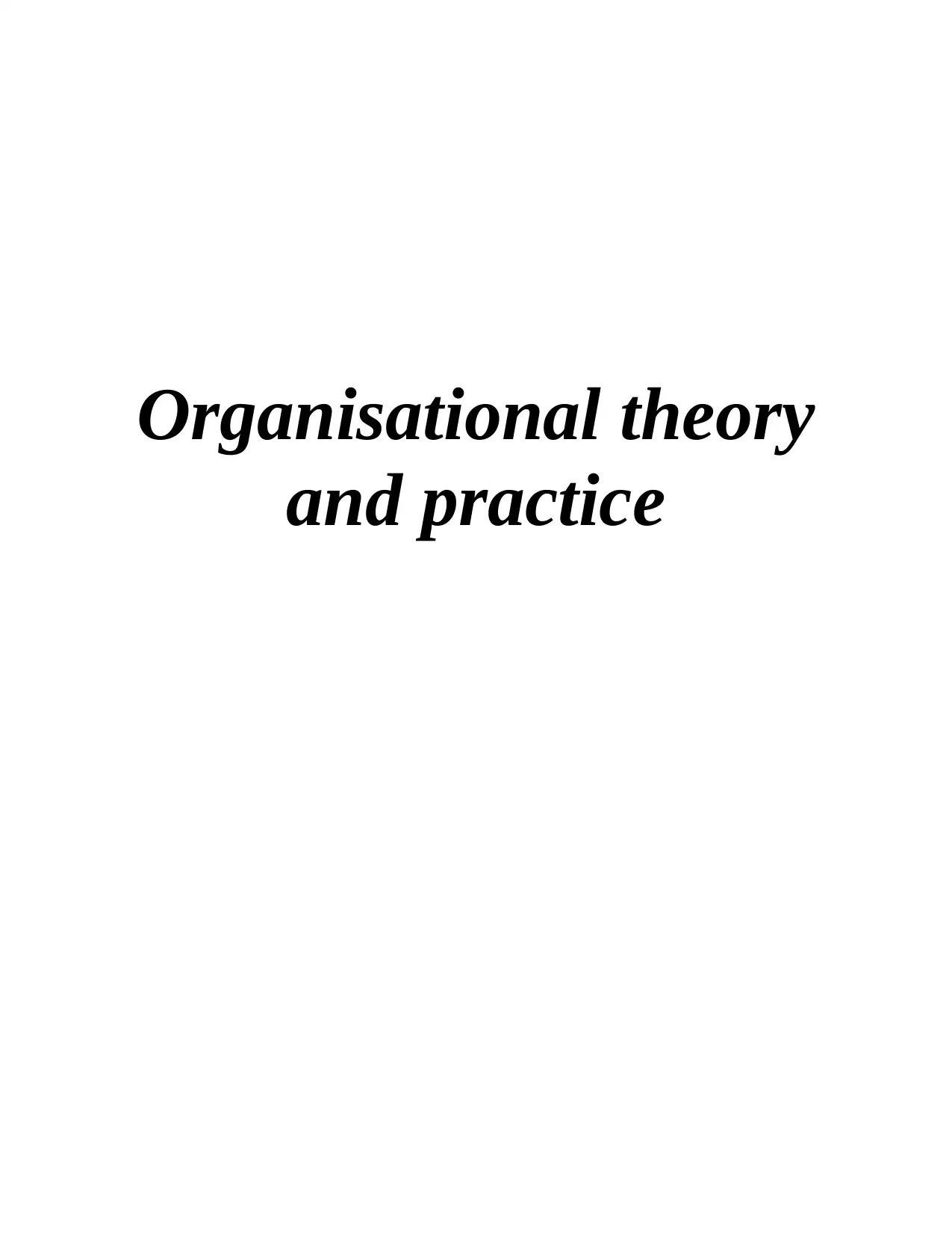
Organisational theory
and practice
and practice
Paraphrase This Document
Need a fresh take? Get an instant paraphrase of this document with our AI Paraphraser
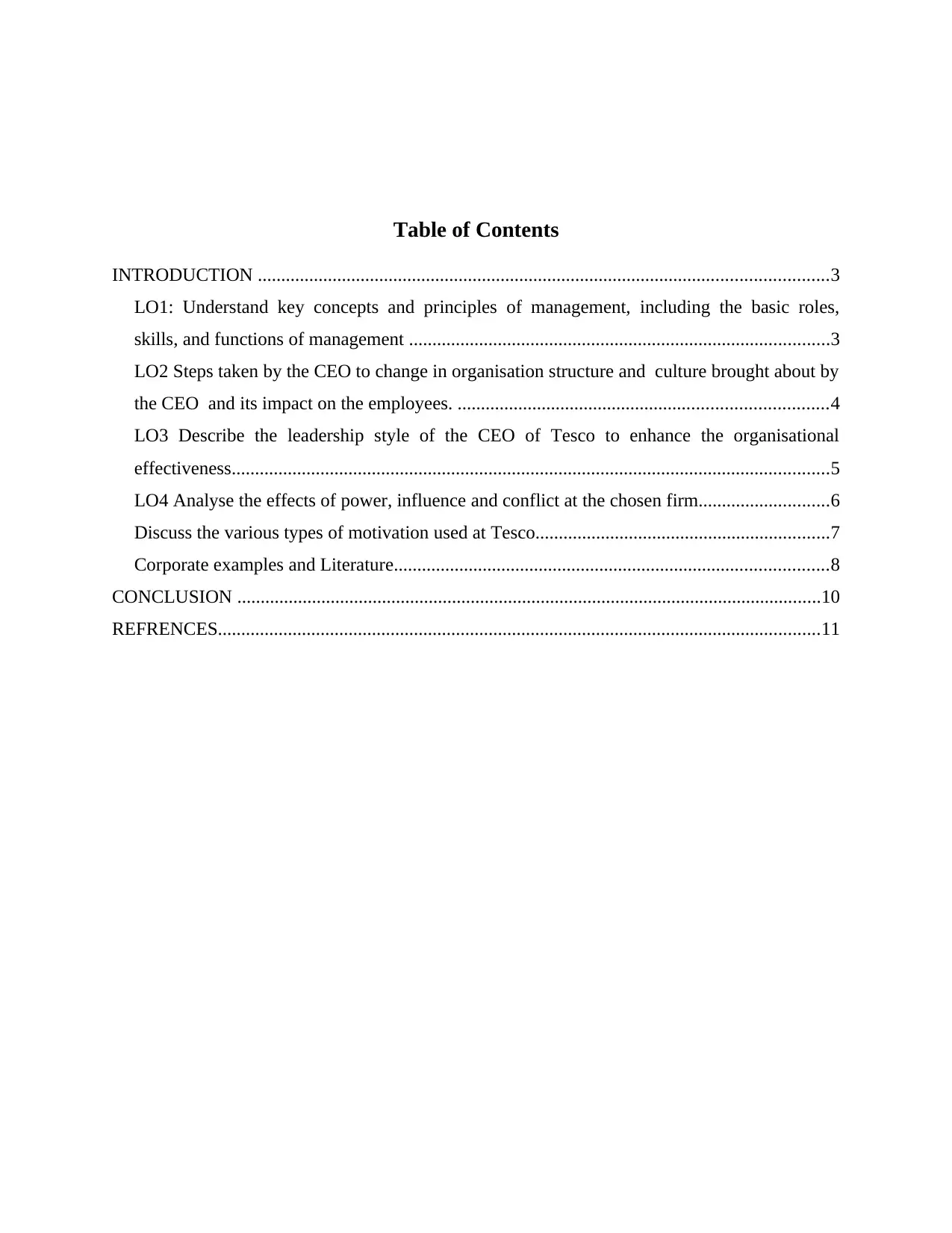
Table of Contents
INTRODUCTION ..........................................................................................................................3
LO1: Understand key concepts and principles of management, including the basic roles,
skills, and functions of management ..........................................................................................3
LO2 Steps taken by the CEO to change in organisation structure and culture brought about by
the CEO and its impact on the employees. ...............................................................................4
LO3 Describe the leadership style of the CEO of Tesco to enhance the organisational
effectiveness................................................................................................................................5
LO4 Analyse the effects of power, influence and conflict at the chosen firm............................6
Discuss the various types of motivation used at Tesco...............................................................7
Corporate examples and Literature.............................................................................................8
CONCLUSION .............................................................................................................................10
REFRENCES.................................................................................................................................11
INTRODUCTION ..........................................................................................................................3
LO1: Understand key concepts and principles of management, including the basic roles,
skills, and functions of management ..........................................................................................3
LO2 Steps taken by the CEO to change in organisation structure and culture brought about by
the CEO and its impact on the employees. ...............................................................................4
LO3 Describe the leadership style of the CEO of Tesco to enhance the organisational
effectiveness................................................................................................................................5
LO4 Analyse the effects of power, influence and conflict at the chosen firm............................6
Discuss the various types of motivation used at Tesco...............................................................7
Corporate examples and Literature.............................................................................................8
CONCLUSION .............................................................................................................................10
REFRENCES.................................................................................................................................11
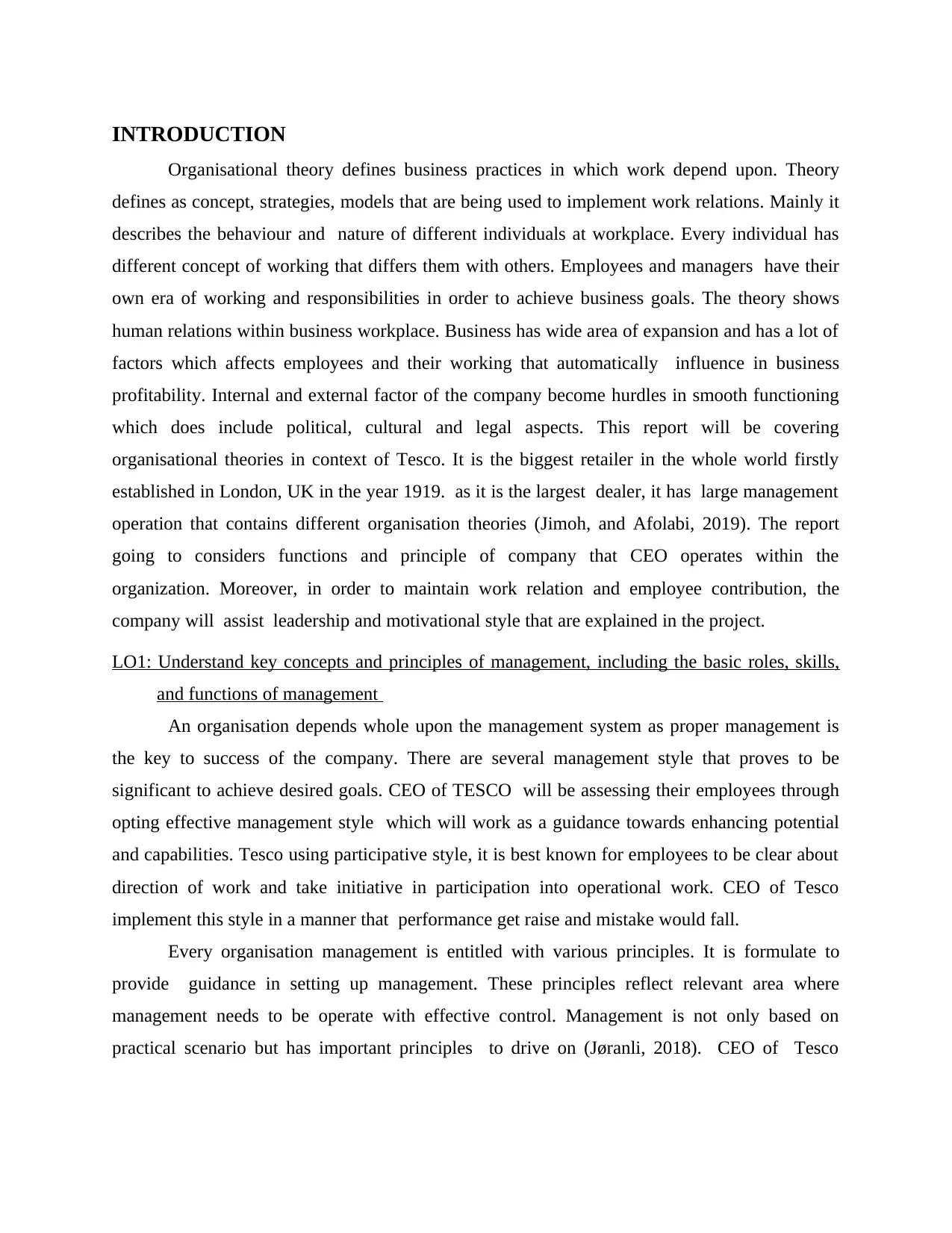
INTRODUCTION
Organisational theory defines business practices in which work depend upon. Theory
defines as concept, strategies, models that are being used to implement work relations. Mainly it
describes the behaviour and nature of different individuals at workplace. Every individual has
different concept of working that differs them with others. Employees and managers have their
own era of working and responsibilities in order to achieve business goals. The theory shows
human relations within business workplace. Business has wide area of expansion and has a lot of
factors which affects employees and their working that automatically influence in business
profitability. Internal and external factor of the company become hurdles in smooth functioning
which does include political, cultural and legal aspects. This report will be covering
organisational theories in context of Tesco. It is the biggest retailer in the whole world firstly
established in London, UK in the year 1919. as it is the largest dealer, it has large management
operation that contains different organisation theories (Jimoh, and Afolabi, 2019). The report
going to considers functions and principle of company that CEO operates within the
organization. Moreover, in order to maintain work relation and employee contribution, the
company will assist leadership and motivational style that are explained in the project.
LO1: Understand key concepts and principles of management, including the basic roles, skills,
and functions of management
An organisation depends whole upon the management system as proper management is
the key to success of the company. There are several management style that proves to be
significant to achieve desired goals. CEO of TESCO will be assessing their employees through
opting effective management style which will work as a guidance towards enhancing potential
and capabilities. Tesco using participative style, it is best known for employees to be clear about
direction of work and take initiative in participation into operational work. CEO of Tesco
implement this style in a manner that performance get raise and mistake would fall.
Every organisation management is entitled with various principles. It is formulate to
provide guidance in setting up management. These principles reflect relevant area where
management needs to be operate with effective control. Management is not only based on
practical scenario but has important principles to drive on (Jøranli, 2018). CEO of Tesco
Organisational theory defines business practices in which work depend upon. Theory
defines as concept, strategies, models that are being used to implement work relations. Mainly it
describes the behaviour and nature of different individuals at workplace. Every individual has
different concept of working that differs them with others. Employees and managers have their
own era of working and responsibilities in order to achieve business goals. The theory shows
human relations within business workplace. Business has wide area of expansion and has a lot of
factors which affects employees and their working that automatically influence in business
profitability. Internal and external factor of the company become hurdles in smooth functioning
which does include political, cultural and legal aspects. This report will be covering
organisational theories in context of Tesco. It is the biggest retailer in the whole world firstly
established in London, UK in the year 1919. as it is the largest dealer, it has large management
operation that contains different organisation theories (Jimoh, and Afolabi, 2019). The report
going to considers functions and principle of company that CEO operates within the
organization. Moreover, in order to maintain work relation and employee contribution, the
company will assist leadership and motivational style that are explained in the project.
LO1: Understand key concepts and principles of management, including the basic roles, skills,
and functions of management
An organisation depends whole upon the management system as proper management is
the key to success of the company. There are several management style that proves to be
significant to achieve desired goals. CEO of TESCO will be assessing their employees through
opting effective management style which will work as a guidance towards enhancing potential
and capabilities. Tesco using participative style, it is best known for employees to be clear about
direction of work and take initiative in participation into operational work. CEO of Tesco
implement this style in a manner that performance get raise and mistake would fall.
Every organisation management is entitled with various principles. It is formulate to
provide guidance in setting up management. These principles reflect relevant area where
management needs to be operate with effective control. Management is not only based on
practical scenario but has important principles to drive on (Jøranli, 2018). CEO of Tesco
⊘ This is a preview!⊘
Do you want full access?
Subscribe today to unlock all pages.

Trusted by 1+ million students worldwide
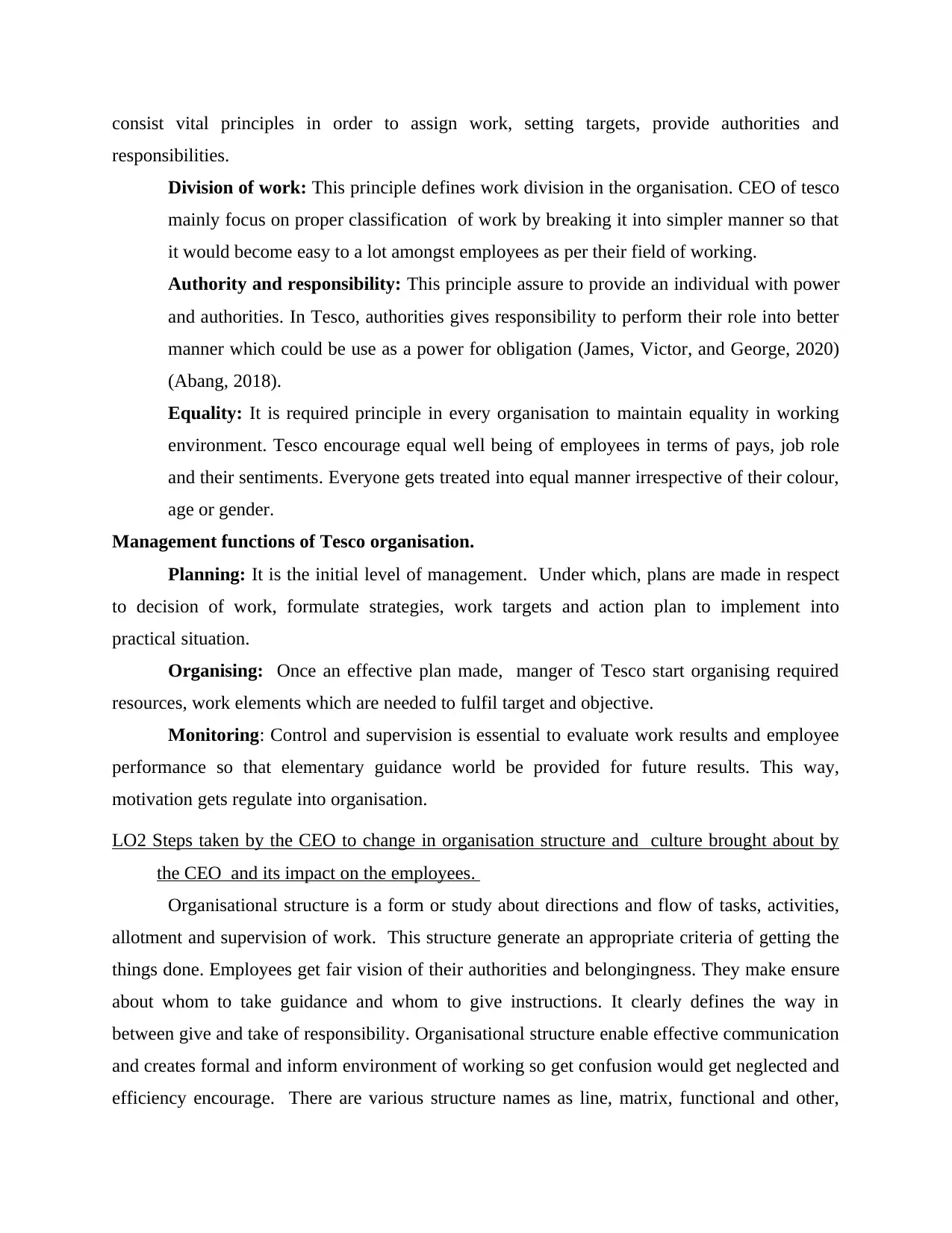
consist vital principles in order to assign work, setting targets, provide authorities and
responsibilities.
Division of work: This principle defines work division in the organisation. CEO of tesco
mainly focus on proper classification of work by breaking it into simpler manner so that
it would become easy to a lot amongst employees as per their field of working.
Authority and responsibility: This principle assure to provide an individual with power
and authorities. In Tesco, authorities gives responsibility to perform their role into better
manner which could be use as a power for obligation (James, Victor, and George, 2020)
(Abang, 2018).
Equality: It is required principle in every organisation to maintain equality in working
environment. Tesco encourage equal well being of employees in terms of pays, job role
and their sentiments. Everyone gets treated into equal manner irrespective of their colour,
age or gender.
Management functions of Tesco organisation.
Planning: It is the initial level of management. Under which, plans are made in respect
to decision of work, formulate strategies, work targets and action plan to implement into
practical situation.
Organising: Once an effective plan made, manger of Tesco start organising required
resources, work elements which are needed to fulfil target and objective.
Monitoring: Control and supervision is essential to evaluate work results and employee
performance so that elementary guidance world be provided for future results. This way,
motivation gets regulate into organisation.
LO2 Steps taken by the CEO to change in organisation structure and culture brought about by
the CEO and its impact on the employees.
Organisational structure is a form or study about directions and flow of tasks, activities,
allotment and supervision of work. This structure generate an appropriate criteria of getting the
things done. Employees get fair vision of their authorities and belongingness. They make ensure
about whom to take guidance and whom to give instructions. It clearly defines the way in
between give and take of responsibility. Organisational structure enable effective communication
and creates formal and inform environment of working so get confusion would get neglected and
efficiency encourage. There are various structure names as line, matrix, functional and other,
responsibilities.
Division of work: This principle defines work division in the organisation. CEO of tesco
mainly focus on proper classification of work by breaking it into simpler manner so that
it would become easy to a lot amongst employees as per their field of working.
Authority and responsibility: This principle assure to provide an individual with power
and authorities. In Tesco, authorities gives responsibility to perform their role into better
manner which could be use as a power for obligation (James, Victor, and George, 2020)
(Abang, 2018).
Equality: It is required principle in every organisation to maintain equality in working
environment. Tesco encourage equal well being of employees in terms of pays, job role
and their sentiments. Everyone gets treated into equal manner irrespective of their colour,
age or gender.
Management functions of Tesco organisation.
Planning: It is the initial level of management. Under which, plans are made in respect
to decision of work, formulate strategies, work targets and action plan to implement into
practical situation.
Organising: Once an effective plan made, manger of Tesco start organising required
resources, work elements which are needed to fulfil target and objective.
Monitoring: Control and supervision is essential to evaluate work results and employee
performance so that elementary guidance world be provided for future results. This way,
motivation gets regulate into organisation.
LO2 Steps taken by the CEO to change in organisation structure and culture brought about by
the CEO and its impact on the employees.
Organisational structure is a form or study about directions and flow of tasks, activities,
allotment and supervision of work. This structure generate an appropriate criteria of getting the
things done. Employees get fair vision of their authorities and belongingness. They make ensure
about whom to take guidance and whom to give instructions. It clearly defines the way in
between give and take of responsibility. Organisational structure enable effective communication
and creates formal and inform environment of working so get confusion would get neglected and
efficiency encourage. There are various structure names as line, matrix, functional and other,
Paraphrase This Document
Need a fresh take? Get an instant paraphrase of this document with our AI Paraphraser
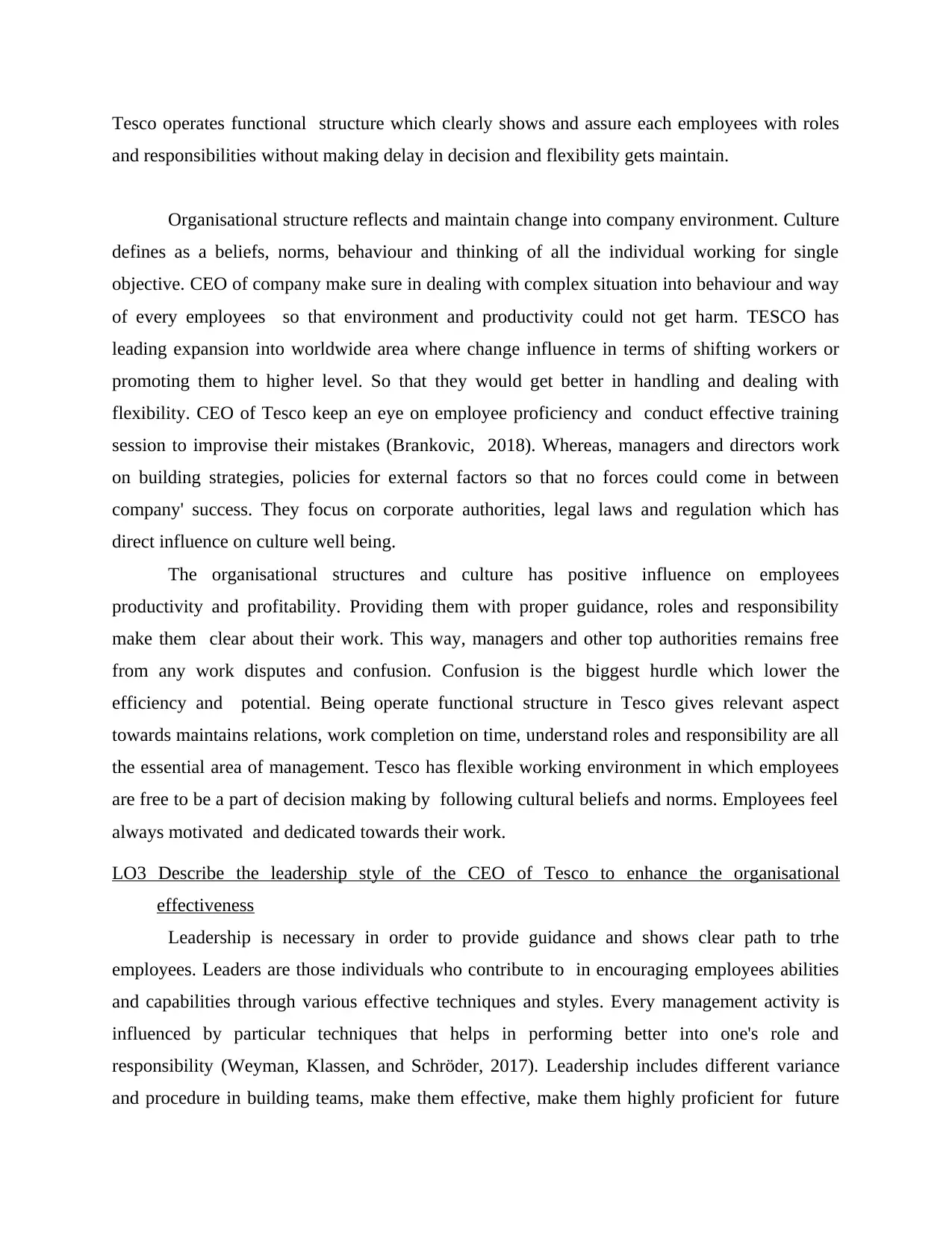
Tesco operates functional structure which clearly shows and assure each employees with roles
and responsibilities without making delay in decision and flexibility gets maintain.
Organisational structure reflects and maintain change into company environment. Culture
defines as a beliefs, norms, behaviour and thinking of all the individual working for single
objective. CEO of company make sure in dealing with complex situation into behaviour and way
of every employees so that environment and productivity could not get harm. TESCO has
leading expansion into worldwide area where change influence in terms of shifting workers or
promoting them to higher level. So that they would get better in handling and dealing with
flexibility. CEO of Tesco keep an eye on employee proficiency and conduct effective training
session to improvise their mistakes (Brankovic, 2018). Whereas, managers and directors work
on building strategies, policies for external factors so that no forces could come in between
company' success. They focus on corporate authorities, legal laws and regulation which has
direct influence on culture well being.
The organisational structures and culture has positive influence on employees
productivity and profitability. Providing them with proper guidance, roles and responsibility
make them clear about their work. This way, managers and other top authorities remains free
from any work disputes and confusion. Confusion is the biggest hurdle which lower the
efficiency and potential. Being operate functional structure in Tesco gives relevant aspect
towards maintains relations, work completion on time, understand roles and responsibility are all
the essential area of management. Tesco has flexible working environment in which employees
are free to be a part of decision making by following cultural beliefs and norms. Employees feel
always motivated and dedicated towards their work.
LO3 Describe the leadership style of the CEO of Tesco to enhance the organisational
effectiveness
Leadership is necessary in order to provide guidance and shows clear path to trhe
employees. Leaders are those individuals who contribute to in encouraging employees abilities
and capabilities through various effective techniques and styles. Every management activity is
influenced by particular techniques that helps in performing better into one's role and
responsibility (Weyman, Klassen, and Schröder, 2017). Leadership includes different variance
and procedure in building teams, make them effective, make them highly proficient for future
and responsibilities without making delay in decision and flexibility gets maintain.
Organisational structure reflects and maintain change into company environment. Culture
defines as a beliefs, norms, behaviour and thinking of all the individual working for single
objective. CEO of company make sure in dealing with complex situation into behaviour and way
of every employees so that environment and productivity could not get harm. TESCO has
leading expansion into worldwide area where change influence in terms of shifting workers or
promoting them to higher level. So that they would get better in handling and dealing with
flexibility. CEO of Tesco keep an eye on employee proficiency and conduct effective training
session to improvise their mistakes (Brankovic, 2018). Whereas, managers and directors work
on building strategies, policies for external factors so that no forces could come in between
company' success. They focus on corporate authorities, legal laws and regulation which has
direct influence on culture well being.
The organisational structures and culture has positive influence on employees
productivity and profitability. Providing them with proper guidance, roles and responsibility
make them clear about their work. This way, managers and other top authorities remains free
from any work disputes and confusion. Confusion is the biggest hurdle which lower the
efficiency and potential. Being operate functional structure in Tesco gives relevant aspect
towards maintains relations, work completion on time, understand roles and responsibility are all
the essential area of management. Tesco has flexible working environment in which employees
are free to be a part of decision making by following cultural beliefs and norms. Employees feel
always motivated and dedicated towards their work.
LO3 Describe the leadership style of the CEO of Tesco to enhance the organisational
effectiveness
Leadership is necessary in order to provide guidance and shows clear path to trhe
employees. Leaders are those individuals who contribute to in encouraging employees abilities
and capabilities through various effective techniques and styles. Every management activity is
influenced by particular techniques that helps in performing better into one's role and
responsibility (Weyman, Klassen, and Schröder, 2017). Leadership includes different variance
and procedure in building teams, make them effective, make them highly proficient for future
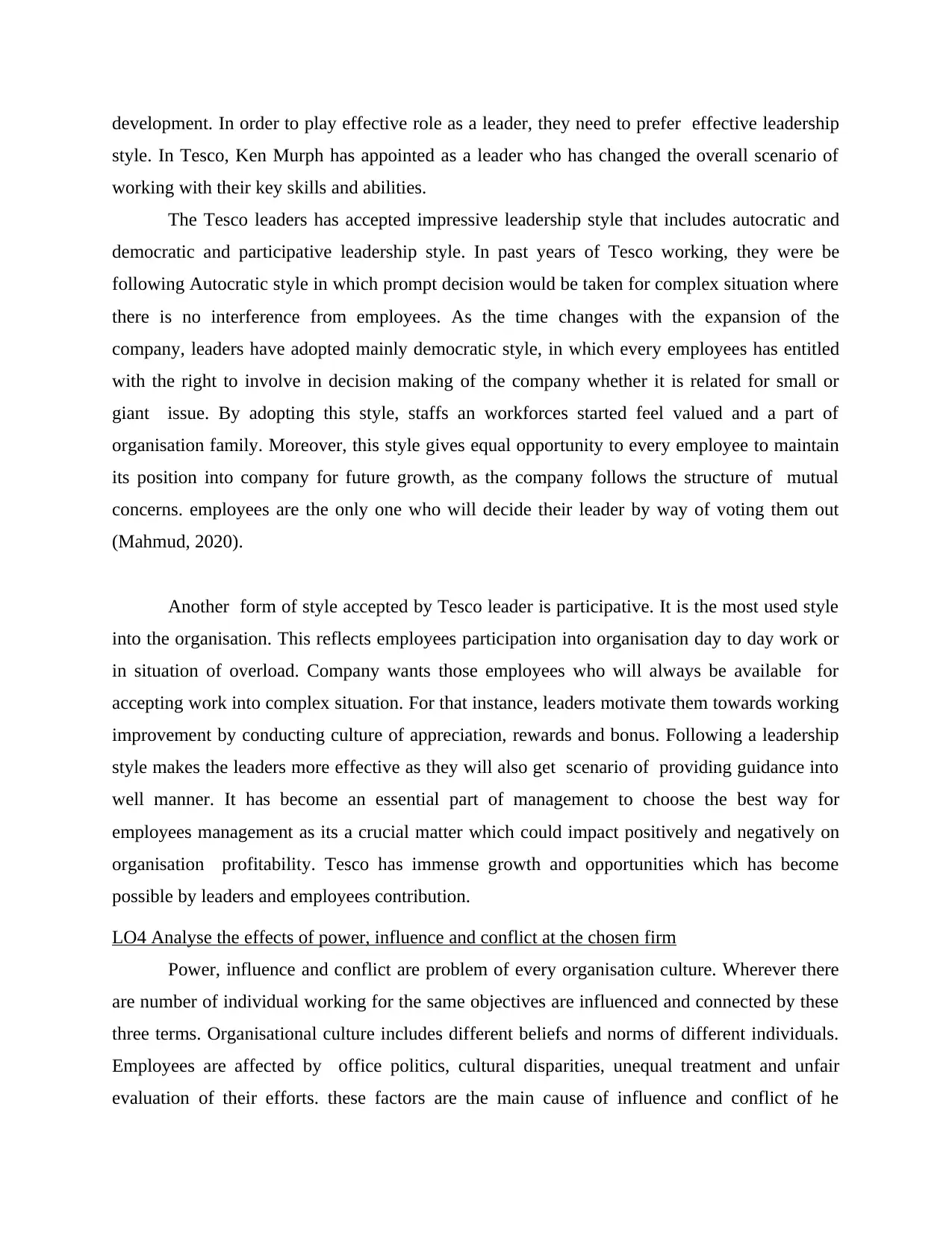
development. In order to play effective role as a leader, they need to prefer effective leadership
style. In Tesco, Ken Murph has appointed as a leader who has changed the overall scenario of
working with their key skills and abilities.
The Tesco leaders has accepted impressive leadership style that includes autocratic and
democratic and participative leadership style. In past years of Tesco working, they were be
following Autocratic style in which prompt decision would be taken for complex situation where
there is no interference from employees. As the time changes with the expansion of the
company, leaders have adopted mainly democratic style, in which every employees has entitled
with the right to involve in decision making of the company whether it is related for small or
giant issue. By adopting this style, staffs an workforces started feel valued and a part of
organisation family. Moreover, this style gives equal opportunity to every employee to maintain
its position into company for future growth, as the company follows the structure of mutual
concerns. employees are the only one who will decide their leader by way of voting them out
(Mahmud, 2020).
Another form of style accepted by Tesco leader is participative. It is the most used style
into the organisation. This reflects employees participation into organisation day to day work or
in situation of overload. Company wants those employees who will always be available for
accepting work into complex situation. For that instance, leaders motivate them towards working
improvement by conducting culture of appreciation, rewards and bonus. Following a leadership
style makes the leaders more effective as they will also get scenario of providing guidance into
well manner. It has become an essential part of management to choose the best way for
employees management as its a crucial matter which could impact positively and negatively on
organisation profitability. Tesco has immense growth and opportunities which has become
possible by leaders and employees contribution.
LO4 Analyse the effects of power, influence and conflict at the chosen firm
Power, influence and conflict are problem of every organisation culture. Wherever there
are number of individual working for the same objectives are influenced and connected by these
three terms. Organisational culture includes different beliefs and norms of different individuals.
Employees are affected by office politics, cultural disparities, unequal treatment and unfair
evaluation of their efforts. these factors are the main cause of influence and conflict of he
style. In Tesco, Ken Murph has appointed as a leader who has changed the overall scenario of
working with their key skills and abilities.
The Tesco leaders has accepted impressive leadership style that includes autocratic and
democratic and participative leadership style. In past years of Tesco working, they were be
following Autocratic style in which prompt decision would be taken for complex situation where
there is no interference from employees. As the time changes with the expansion of the
company, leaders have adopted mainly democratic style, in which every employees has entitled
with the right to involve in decision making of the company whether it is related for small or
giant issue. By adopting this style, staffs an workforces started feel valued and a part of
organisation family. Moreover, this style gives equal opportunity to every employee to maintain
its position into company for future growth, as the company follows the structure of mutual
concerns. employees are the only one who will decide their leader by way of voting them out
(Mahmud, 2020).
Another form of style accepted by Tesco leader is participative. It is the most used style
into the organisation. This reflects employees participation into organisation day to day work or
in situation of overload. Company wants those employees who will always be available for
accepting work into complex situation. For that instance, leaders motivate them towards working
improvement by conducting culture of appreciation, rewards and bonus. Following a leadership
style makes the leaders more effective as they will also get scenario of providing guidance into
well manner. It has become an essential part of management to choose the best way for
employees management as its a crucial matter which could impact positively and negatively on
organisation profitability. Tesco has immense growth and opportunities which has become
possible by leaders and employees contribution.
LO4 Analyse the effects of power, influence and conflict at the chosen firm
Power, influence and conflict are problem of every organisation culture. Wherever there
are number of individual working for the same objectives are influenced and connected by these
three terms. Organisational culture includes different beliefs and norms of different individuals.
Employees are affected by office politics, cultural disparities, unequal treatment and unfair
evaluation of their efforts. these factors are the main cause of influence and conflict of he
⊘ This is a preview!⊘
Do you want full access?
Subscribe today to unlock all pages.

Trusted by 1+ million students worldwide
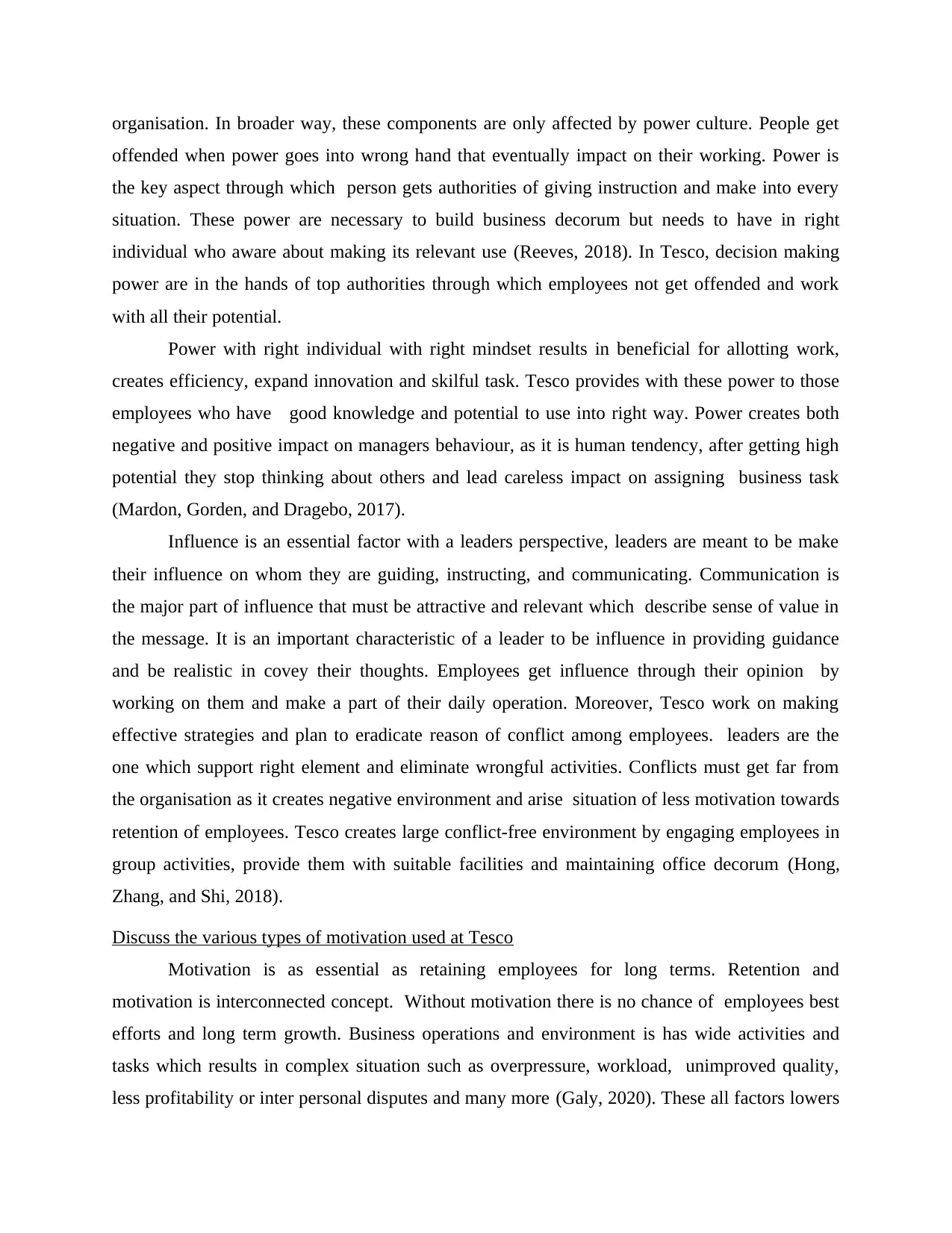
organisation. In broader way, these components are only affected by power culture. People get
offended when power goes into wrong hand that eventually impact on their working. Power is
the key aspect through which person gets authorities of giving instruction and make into every
situation. These power are necessary to build business decorum but needs to have in right
individual who aware about making its relevant use (Reeves, 2018). In Tesco, decision making
power are in the hands of top authorities through which employees not get offended and work
with all their potential.
Power with right individual with right mindset results in beneficial for allotting work,
creates efficiency, expand innovation and skilful task. Tesco provides with these power to those
employees who have good knowledge and potential to use into right way. Power creates both
negative and positive impact on managers behaviour, as it is human tendency, after getting high
potential they stop thinking about others and lead careless impact on assigning business task
(Mardon, Gorden, and Dragebo, 2017).
Influence is an essential factor with a leaders perspective, leaders are meant to be make
their influence on whom they are guiding, instructing, and communicating. Communication is
the major part of influence that must be attractive and relevant which describe sense of value in
the message. It is an important characteristic of a leader to be influence in providing guidance
and be realistic in covey their thoughts. Employees get influence through their opinion by
working on them and make a part of their daily operation. Moreover, Tesco work on making
effective strategies and plan to eradicate reason of conflict among employees. leaders are the
one which support right element and eliminate wrongful activities. Conflicts must get far from
the organisation as it creates negative environment and arise situation of less motivation towards
retention of employees. Tesco creates large conflict-free environment by engaging employees in
group activities, provide them with suitable facilities and maintaining office decorum (Hong,
Zhang, and Shi, 2018).
Discuss the various types of motivation used at Tesco
Motivation is as essential as retaining employees for long terms. Retention and
motivation is interconnected concept. Without motivation there is no chance of employees best
efforts and long term growth. Business operations and environment is has wide activities and
tasks which results in complex situation such as overpressure, workload, unimproved quality,
less profitability or inter personal disputes and many more (Galy, 2020). These all factors lowers
offended when power goes into wrong hand that eventually impact on their working. Power is
the key aspect through which person gets authorities of giving instruction and make into every
situation. These power are necessary to build business decorum but needs to have in right
individual who aware about making its relevant use (Reeves, 2018). In Tesco, decision making
power are in the hands of top authorities through which employees not get offended and work
with all their potential.
Power with right individual with right mindset results in beneficial for allotting work,
creates efficiency, expand innovation and skilful task. Tesco provides with these power to those
employees who have good knowledge and potential to use into right way. Power creates both
negative and positive impact on managers behaviour, as it is human tendency, after getting high
potential they stop thinking about others and lead careless impact on assigning business task
(Mardon, Gorden, and Dragebo, 2017).
Influence is an essential factor with a leaders perspective, leaders are meant to be make
their influence on whom they are guiding, instructing, and communicating. Communication is
the major part of influence that must be attractive and relevant which describe sense of value in
the message. It is an important characteristic of a leader to be influence in providing guidance
and be realistic in covey their thoughts. Employees get influence through their opinion by
working on them and make a part of their daily operation. Moreover, Tesco work on making
effective strategies and plan to eradicate reason of conflict among employees. leaders are the
one which support right element and eliminate wrongful activities. Conflicts must get far from
the organisation as it creates negative environment and arise situation of less motivation towards
retention of employees. Tesco creates large conflict-free environment by engaging employees in
group activities, provide them with suitable facilities and maintaining office decorum (Hong,
Zhang, and Shi, 2018).
Discuss the various types of motivation used at Tesco
Motivation is as essential as retaining employees for long terms. Retention and
motivation is interconnected concept. Without motivation there is no chance of employees best
efforts and long term growth. Business operations and environment is has wide activities and
tasks which results in complex situation such as overpressure, workload, unimproved quality,
less profitability or inter personal disputes and many more (Galy, 2020). These all factors lowers
Paraphrase This Document
Need a fresh take? Get an instant paraphrase of this document with our AI Paraphraser
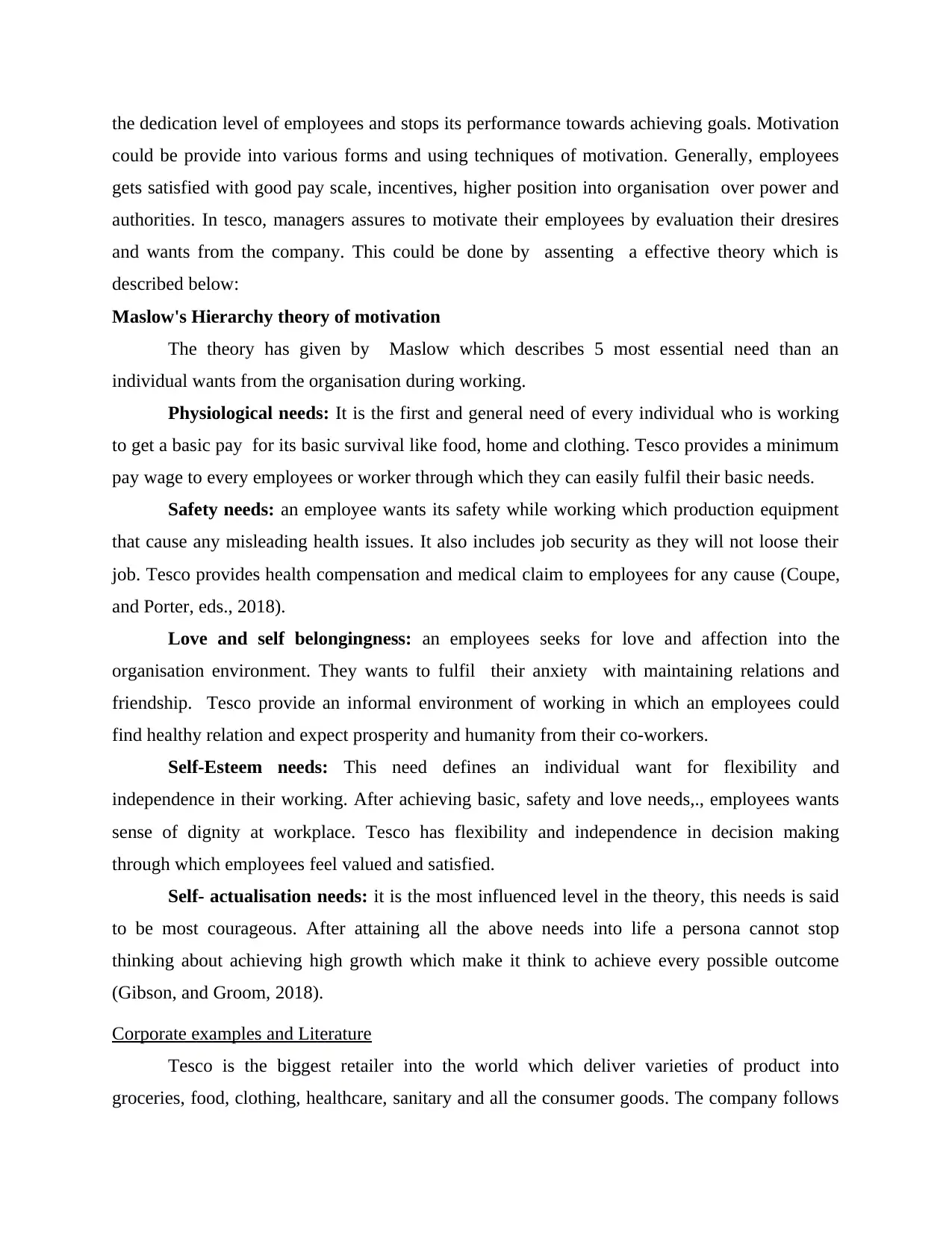
the dedication level of employees and stops its performance towards achieving goals. Motivation
could be provide into various forms and using techniques of motivation. Generally, employees
gets satisfied with good pay scale, incentives, higher position into organisation over power and
authorities. In tesco, managers assures to motivate their employees by evaluation their dresires
and wants from the company. This could be done by assenting a effective theory which is
described below:
Maslow's Hierarchy theory of motivation
The theory has given by Maslow which describes 5 most essential need than an
individual wants from the organisation during working.
Physiological needs: It is the first and general need of every individual who is working
to get a basic pay for its basic survival like food, home and clothing. Tesco provides a minimum
pay wage to every employees or worker through which they can easily fulfil their basic needs.
Safety needs: an employee wants its safety while working which production equipment
that cause any misleading health issues. It also includes job security as they will not loose their
job. Tesco provides health compensation and medical claim to employees for any cause (Coupe,
and Porter, eds., 2018).
Love and self belongingness: an employees seeks for love and affection into the
organisation environment. They wants to fulfil their anxiety with maintaining relations and
friendship. Tesco provide an informal environment of working in which an employees could
find healthy relation and expect prosperity and humanity from their co-workers.
Self-Esteem needs: This need defines an individual want for flexibility and
independence in their working. After achieving basic, safety and love needs,., employees wants
sense of dignity at workplace. Tesco has flexibility and independence in decision making
through which employees feel valued and satisfied.
Self- actualisation needs: it is the most influenced level in the theory, this needs is said
to be most courageous. After attaining all the above needs into life a persona cannot stop
thinking about achieving high growth which make it think to achieve every possible outcome
(Gibson, and Groom, 2018).
Corporate examples and Literature
Tesco is the biggest retailer into the world which deliver varieties of product into
groceries, food, clothing, healthcare, sanitary and all the consumer goods. The company follows
could be provide into various forms and using techniques of motivation. Generally, employees
gets satisfied with good pay scale, incentives, higher position into organisation over power and
authorities. In tesco, managers assures to motivate their employees by evaluation their dresires
and wants from the company. This could be done by assenting a effective theory which is
described below:
Maslow's Hierarchy theory of motivation
The theory has given by Maslow which describes 5 most essential need than an
individual wants from the organisation during working.
Physiological needs: It is the first and general need of every individual who is working
to get a basic pay for its basic survival like food, home and clothing. Tesco provides a minimum
pay wage to every employees or worker through which they can easily fulfil their basic needs.
Safety needs: an employee wants its safety while working which production equipment
that cause any misleading health issues. It also includes job security as they will not loose their
job. Tesco provides health compensation and medical claim to employees for any cause (Coupe,
and Porter, eds., 2018).
Love and self belongingness: an employees seeks for love and affection into the
organisation environment. They wants to fulfil their anxiety with maintaining relations and
friendship. Tesco provide an informal environment of working in which an employees could
find healthy relation and expect prosperity and humanity from their co-workers.
Self-Esteem needs: This need defines an individual want for flexibility and
independence in their working. After achieving basic, safety and love needs,., employees wants
sense of dignity at workplace. Tesco has flexibility and independence in decision making
through which employees feel valued and satisfied.
Self- actualisation needs: it is the most influenced level in the theory, this needs is said
to be most courageous. After attaining all the above needs into life a persona cannot stop
thinking about achieving high growth which make it think to achieve every possible outcome
(Gibson, and Groom, 2018).
Corporate examples and Literature
Tesco is the biggest retailer into the world which deliver varieties of product into
groceries, food, clothing, healthcare, sanitary and all the consumer goods. The company follows
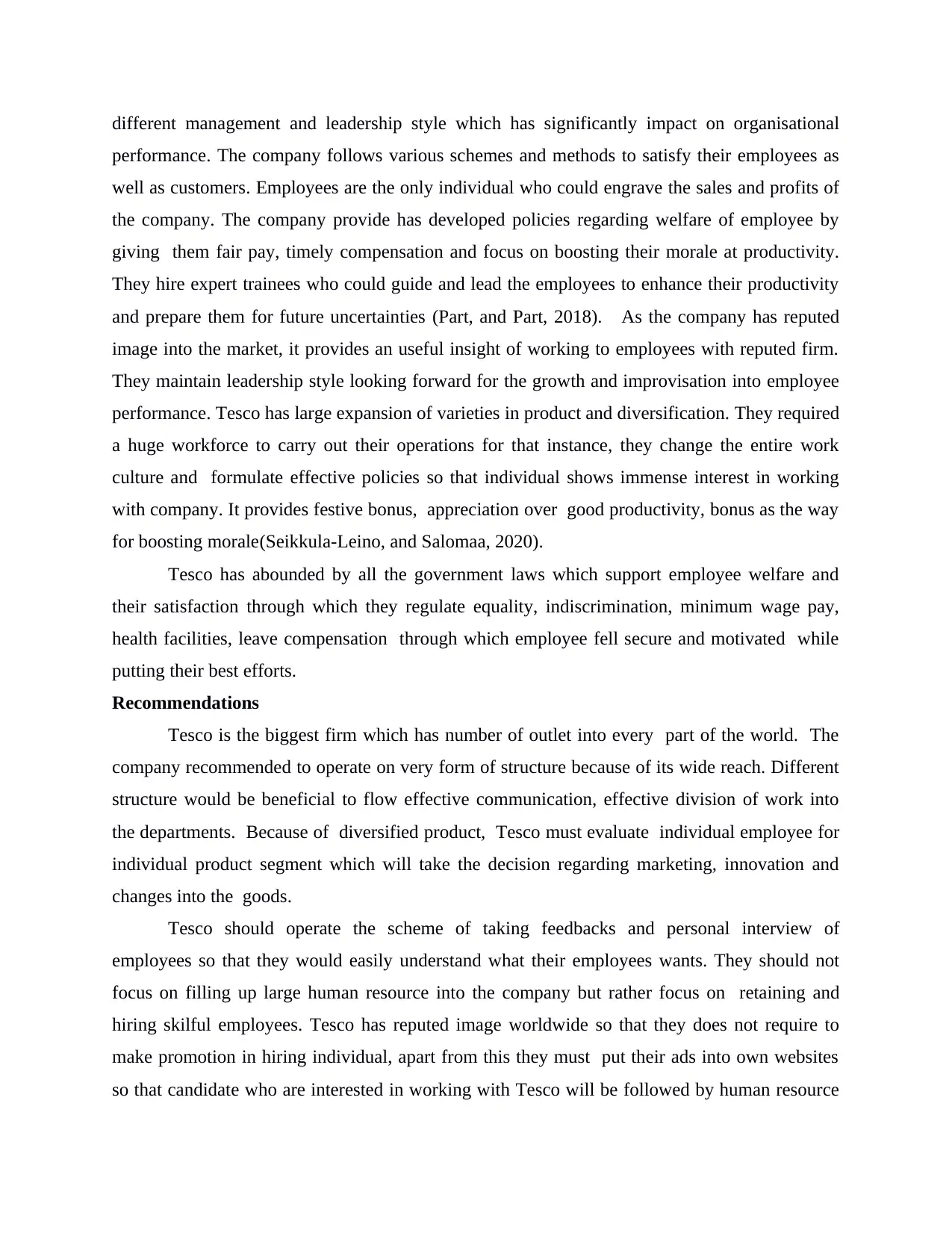
different management and leadership style which has significantly impact on organisational
performance. The company follows various schemes and methods to satisfy their employees as
well as customers. Employees are the only individual who could engrave the sales and profits of
the company. The company provide has developed policies regarding welfare of employee by
giving them fair pay, timely compensation and focus on boosting their morale at productivity.
They hire expert trainees who could guide and lead the employees to enhance their productivity
and prepare them for future uncertainties (Part, and Part, 2018). As the company has reputed
image into the market, it provides an useful insight of working to employees with reputed firm.
They maintain leadership style looking forward for the growth and improvisation into employee
performance. Tesco has large expansion of varieties in product and diversification. They required
a huge workforce to carry out their operations for that instance, they change the entire work
culture and formulate effective policies so that individual shows immense interest in working
with company. It provides festive bonus, appreciation over good productivity, bonus as the way
for boosting morale(Seikkula-Leino, and Salomaa, 2020).
Tesco has abounded by all the government laws which support employee welfare and
their satisfaction through which they regulate equality, indiscrimination, minimum wage pay,
health facilities, leave compensation through which employee fell secure and motivated while
putting their best efforts.
Recommendations
Tesco is the biggest firm which has number of outlet into every part of the world. The
company recommended to operate on very form of structure because of its wide reach. Different
structure would be beneficial to flow effective communication, effective division of work into
the departments. Because of diversified product, Tesco must evaluate individual employee for
individual product segment which will take the decision regarding marketing, innovation and
changes into the goods.
Tesco should operate the scheme of taking feedbacks and personal interview of
employees so that they would easily understand what their employees wants. They should not
focus on filling up large human resource into the company but rather focus on retaining and
hiring skilful employees. Tesco has reputed image worldwide so that they does not require to
make promotion in hiring individual, apart from this they must put their ads into own websites
so that candidate who are interested in working with Tesco will be followed by human resource
performance. The company follows various schemes and methods to satisfy their employees as
well as customers. Employees are the only individual who could engrave the sales and profits of
the company. The company provide has developed policies regarding welfare of employee by
giving them fair pay, timely compensation and focus on boosting their morale at productivity.
They hire expert trainees who could guide and lead the employees to enhance their productivity
and prepare them for future uncertainties (Part, and Part, 2018). As the company has reputed
image into the market, it provides an useful insight of working to employees with reputed firm.
They maintain leadership style looking forward for the growth and improvisation into employee
performance. Tesco has large expansion of varieties in product and diversification. They required
a huge workforce to carry out their operations for that instance, they change the entire work
culture and formulate effective policies so that individual shows immense interest in working
with company. It provides festive bonus, appreciation over good productivity, bonus as the way
for boosting morale(Seikkula-Leino, and Salomaa, 2020).
Tesco has abounded by all the government laws which support employee welfare and
their satisfaction through which they regulate equality, indiscrimination, minimum wage pay,
health facilities, leave compensation through which employee fell secure and motivated while
putting their best efforts.
Recommendations
Tesco is the biggest firm which has number of outlet into every part of the world. The
company recommended to operate on very form of structure because of its wide reach. Different
structure would be beneficial to flow effective communication, effective division of work into
the departments. Because of diversified product, Tesco must evaluate individual employee for
individual product segment which will take the decision regarding marketing, innovation and
changes into the goods.
Tesco should operate the scheme of taking feedbacks and personal interview of
employees so that they would easily understand what their employees wants. They should not
focus on filling up large human resource into the company but rather focus on retaining and
hiring skilful employees. Tesco has reputed image worldwide so that they does not require to
make promotion in hiring individual, apart from this they must put their ads into own websites
so that candidate who are interested in working with Tesco will be followed by human resource
⊘ This is a preview!⊘
Do you want full access?
Subscribe today to unlock all pages.

Trusted by 1+ million students worldwide
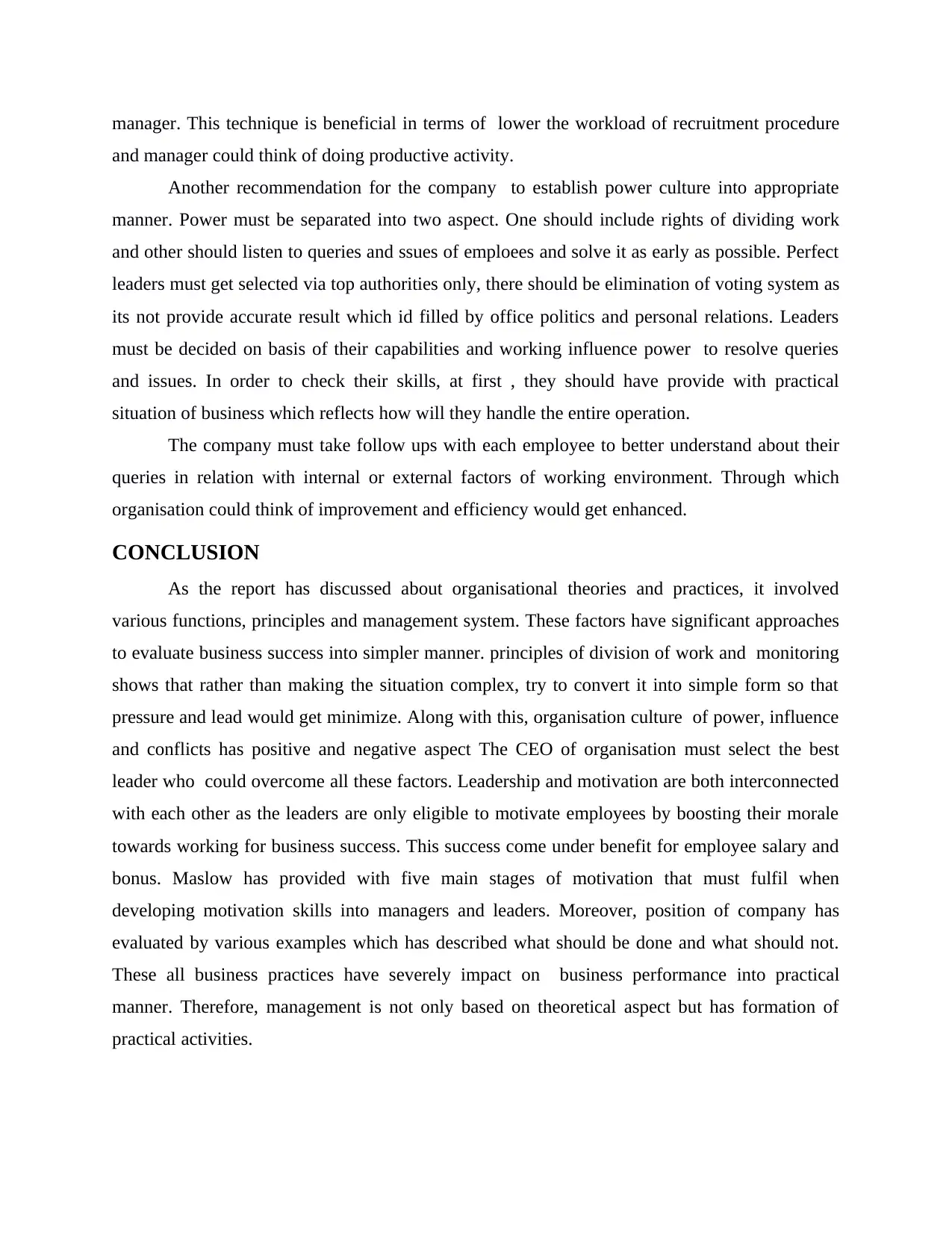
manager. This technique is beneficial in terms of lower the workload of recruitment procedure
and manager could think of doing productive activity.
Another recommendation for the company to establish power culture into appropriate
manner. Power must be separated into two aspect. One should include rights of dividing work
and other should listen to queries and ssues of emploees and solve it as early as possible. Perfect
leaders must get selected via top authorities only, there should be elimination of voting system as
its not provide accurate result which id filled by office politics and personal relations. Leaders
must be decided on basis of their capabilities and working influence power to resolve queries
and issues. In order to check their skills, at first , they should have provide with practical
situation of business which reflects how will they handle the entire operation.
The company must take follow ups with each employee to better understand about their
queries in relation with internal or external factors of working environment. Through which
organisation could think of improvement and efficiency would get enhanced.
CONCLUSION
As the report has discussed about organisational theories and practices, it involved
various functions, principles and management system. These factors have significant approaches
to evaluate business success into simpler manner. principles of division of work and monitoring
shows that rather than making the situation complex, try to convert it into simple form so that
pressure and lead would get minimize. Along with this, organisation culture of power, influence
and conflicts has positive and negative aspect The CEO of organisation must select the best
leader who could overcome all these factors. Leadership and motivation are both interconnected
with each other as the leaders are only eligible to motivate employees by boosting their morale
towards working for business success. This success come under benefit for employee salary and
bonus. Maslow has provided with five main stages of motivation that must fulfil when
developing motivation skills into managers and leaders. Moreover, position of company has
evaluated by various examples which has described what should be done and what should not.
These all business practices have severely impact on business performance into practical
manner. Therefore, management is not only based on theoretical aspect but has formation of
practical activities.
and manager could think of doing productive activity.
Another recommendation for the company to establish power culture into appropriate
manner. Power must be separated into two aspect. One should include rights of dividing work
and other should listen to queries and ssues of emploees and solve it as early as possible. Perfect
leaders must get selected via top authorities only, there should be elimination of voting system as
its not provide accurate result which id filled by office politics and personal relations. Leaders
must be decided on basis of their capabilities and working influence power to resolve queries
and issues. In order to check their skills, at first , they should have provide with practical
situation of business which reflects how will they handle the entire operation.
The company must take follow ups with each employee to better understand about their
queries in relation with internal or external factors of working environment. Through which
organisation could think of improvement and efficiency would get enhanced.
CONCLUSION
As the report has discussed about organisational theories and practices, it involved
various functions, principles and management system. These factors have significant approaches
to evaluate business success into simpler manner. principles of division of work and monitoring
shows that rather than making the situation complex, try to convert it into simple form so that
pressure and lead would get minimize. Along with this, organisation culture of power, influence
and conflicts has positive and negative aspect The CEO of organisation must select the best
leader who could overcome all these factors. Leadership and motivation are both interconnected
with each other as the leaders are only eligible to motivate employees by boosting their morale
towards working for business success. This success come under benefit for employee salary and
bonus. Maslow has provided with five main stages of motivation that must fulfil when
developing motivation skills into managers and leaders. Moreover, position of company has
evaluated by various examples which has described what should be done and what should not.
These all business practices have severely impact on business performance into practical
manner. Therefore, management is not only based on theoretical aspect but has formation of
practical activities.
Paraphrase This Document
Need a fresh take? Get an instant paraphrase of this document with our AI Paraphraser

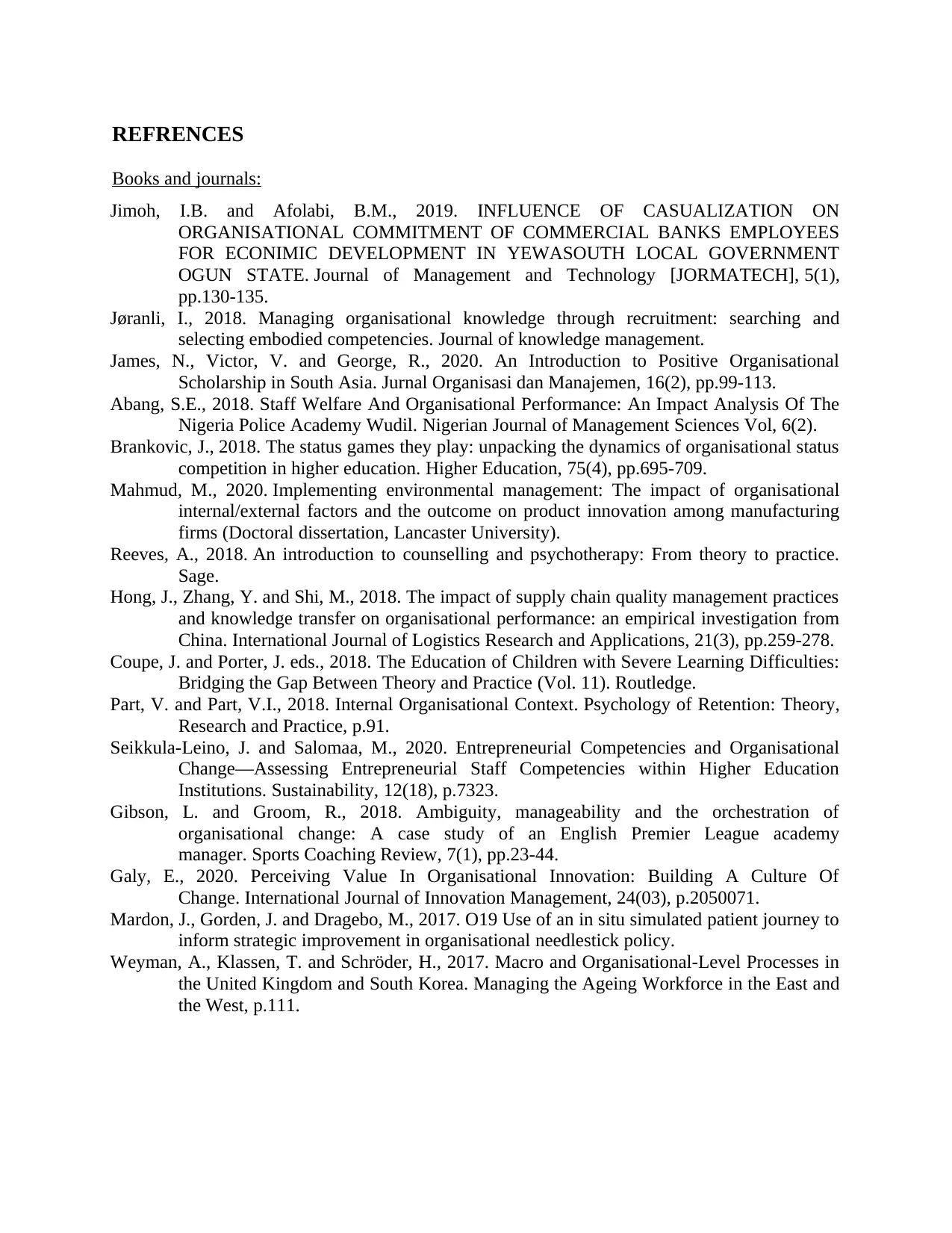
REFRENCES
Books and journals:
Jimoh, I.B. and Afolabi, B.M., 2019. INFLUENCE OF CASUALIZATION ON
ORGANISATIONAL COMMITMENT OF COMMERCIAL BANKS EMPLOYEES
FOR ECONIMIC DEVELOPMENT IN YEWASOUTH LOCAL GOVERNMENT
OGUN STATE. Journal of Management and Technology [JORMATECH], 5(1),
pp.130-135.
Jøranli, I., 2018. Managing organisational knowledge through recruitment: searching and
selecting embodied competencies. Journal of knowledge management.
James, N., Victor, V. and George, R., 2020. An Introduction to Positive Organisational
Scholarship in South Asia. Jurnal Organisasi dan Manajemen, 16(2), pp.99-113.
Abang, S.E., 2018. Staff Welfare And Organisational Performance: An Impact Analysis Of The
Nigeria Police Academy Wudil. Nigerian Journal of Management Sciences Vol, 6(2).
Brankovic, J., 2018. The status games they play: unpacking the dynamics of organisational status
competition in higher education. Higher Education, 75(4), pp.695-709.
Mahmud, M., 2020. Implementing environmental management: The impact of organisational
internal/external factors and the outcome on product innovation among manufacturing
firms (Doctoral dissertation, Lancaster University).
Reeves, A., 2018. An introduction to counselling and psychotherapy: From theory to practice.
Sage.
Hong, J., Zhang, Y. and Shi, M., 2018. The impact of supply chain quality management practices
and knowledge transfer on organisational performance: an empirical investigation from
China. International Journal of Logistics Research and Applications, 21(3), pp.259-278.
Coupe, J. and Porter, J. eds., 2018. The Education of Children with Severe Learning Difficulties:
Bridging the Gap Between Theory and Practice (Vol. 11). Routledge.
Part, V. and Part, V.I., 2018. Internal Organisational Context. Psychology of Retention: Theory,
Research and Practice, p.91.
Seikkula-Leino, J. and Salomaa, M., 2020. Entrepreneurial Competencies and Organisational
Change—Assessing Entrepreneurial Staff Competencies within Higher Education
Institutions. Sustainability, 12(18), p.7323.
Gibson, L. and Groom, R., 2018. Ambiguity, manageability and the orchestration of
organisational change: A case study of an English Premier League academy
manager. Sports Coaching Review, 7(1), pp.23-44.
Galy, E., 2020. Perceiving Value In Organisational Innovation: Building A Culture Of
Change. International Journal of Innovation Management, 24(03), p.2050071.
Mardon, J., Gorden, J. and Dragebo, M., 2017. O19 Use of an in situ simulated patient journey to
inform strategic improvement in organisational needlestick policy.
Weyman, A., Klassen, T. and Schröder, H., 2017. Macro and Organisational-Level Processes in
the United Kingdom and South Korea. Managing the Ageing Workforce in the East and
the West, p.111.
Books and journals:
Jimoh, I.B. and Afolabi, B.M., 2019. INFLUENCE OF CASUALIZATION ON
ORGANISATIONAL COMMITMENT OF COMMERCIAL BANKS EMPLOYEES
FOR ECONIMIC DEVELOPMENT IN YEWASOUTH LOCAL GOVERNMENT
OGUN STATE. Journal of Management and Technology [JORMATECH], 5(1),
pp.130-135.
Jøranli, I., 2018. Managing organisational knowledge through recruitment: searching and
selecting embodied competencies. Journal of knowledge management.
James, N., Victor, V. and George, R., 2020. An Introduction to Positive Organisational
Scholarship in South Asia. Jurnal Organisasi dan Manajemen, 16(2), pp.99-113.
Abang, S.E., 2018. Staff Welfare And Organisational Performance: An Impact Analysis Of The
Nigeria Police Academy Wudil. Nigerian Journal of Management Sciences Vol, 6(2).
Brankovic, J., 2018. The status games they play: unpacking the dynamics of organisational status
competition in higher education. Higher Education, 75(4), pp.695-709.
Mahmud, M., 2020. Implementing environmental management: The impact of organisational
internal/external factors and the outcome on product innovation among manufacturing
firms (Doctoral dissertation, Lancaster University).
Reeves, A., 2018. An introduction to counselling and psychotherapy: From theory to practice.
Sage.
Hong, J., Zhang, Y. and Shi, M., 2018. The impact of supply chain quality management practices
and knowledge transfer on organisational performance: an empirical investigation from
China. International Journal of Logistics Research and Applications, 21(3), pp.259-278.
Coupe, J. and Porter, J. eds., 2018. The Education of Children with Severe Learning Difficulties:
Bridging the Gap Between Theory and Practice (Vol. 11). Routledge.
Part, V. and Part, V.I., 2018. Internal Organisational Context. Psychology of Retention: Theory,
Research and Practice, p.91.
Seikkula-Leino, J. and Salomaa, M., 2020. Entrepreneurial Competencies and Organisational
Change—Assessing Entrepreneurial Staff Competencies within Higher Education
Institutions. Sustainability, 12(18), p.7323.
Gibson, L. and Groom, R., 2018. Ambiguity, manageability and the orchestration of
organisational change: A case study of an English Premier League academy
manager. Sports Coaching Review, 7(1), pp.23-44.
Galy, E., 2020. Perceiving Value In Organisational Innovation: Building A Culture Of
Change. International Journal of Innovation Management, 24(03), p.2050071.
Mardon, J., Gorden, J. and Dragebo, M., 2017. O19 Use of an in situ simulated patient journey to
inform strategic improvement in organisational needlestick policy.
Weyman, A., Klassen, T. and Schröder, H., 2017. Macro and Organisational-Level Processes in
the United Kingdom and South Korea. Managing the Ageing Workforce in the East and
the West, p.111.
⊘ This is a preview!⊘
Do you want full access?
Subscribe today to unlock all pages.

Trusted by 1+ million students worldwide
1 out of 13
Related Documents
Your All-in-One AI-Powered Toolkit for Academic Success.
+13062052269
info@desklib.com
Available 24*7 on WhatsApp / Email
![[object Object]](/_next/static/media/star-bottom.7253800d.svg)
Unlock your academic potential
Copyright © 2020–2025 A2Z Services. All Rights Reserved. Developed and managed by ZUCOL.





